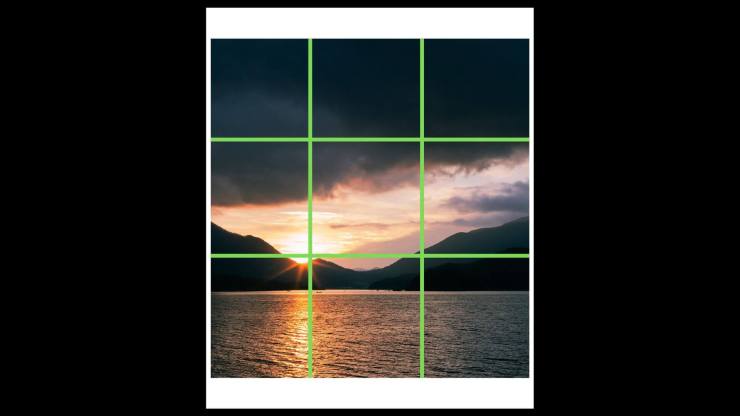In this article, we will discuss the rule of thirds in photography, when it should be broken, and what to keep in mind when doing so.
More of a visual learner? Then check out the video I made on this topic:
What is the rule of thirds in photography?
The rule of thirds divides an image into nine equal parts by two equally-spaced horizontal lines and two equally-spaced vertical lines. The four points where these lines intersect are considered the most important areas of the image. These are where the viewer’s eye is likely to be drawn. By placing your subject at one of these points, you can create a more balanced and aesthetically pleasing composition.

Why is it called the rule of thirds?
The name comes from the fact that the lines divide the image into thirds. It’s believed that this ratio is closest to what our eyes naturally find attractive, which gives your photos a more pleasing overall look.
Is it really a rule?
Although it’s called the “rule” of thirds, it doesn’t have to be strictly followed all the time. There are many times when you might want to break the rule in order to create an interesting or unique composition.
When should you break the rule of thirds in photography?
The rule of thirds is only a guideline, not a strict rule. In some cases, it may be beneficial to break the rule of thirds in order to create a more dynamic composition. Here are a few situations when breaking this rule can be helpful:
- When creating symmetry: Symmetrical compositions often look best when the subject is placed at the center of the frame, as this creates a pleasing balance.
- When creating a sense of movement: Placing your subject off-center can help create the illusion of motion, as it gives the viewer’s eye something to move toward.
- When creating a unique composition: Breaking the rule of thirds can give you an opportunity to create a unique and unexpected composition.
When should you follow the rule of thirds?
The rule of thirds should be followed in certain situations, such as when you’re trying to create a balanced portrait or landscape. In these cases, it’s best to stick with the tried and true rule of thirds for your composition.
Put simply, the rule of thirds is one of many photography composition techniques, so it’s not a matter of when or when to not break the “rule,” but what composition technique would be best to use given the setting in front of you and the story you want to tell with your image.

What to keep in mind when breaking this rule?
When breaking the rule of thirds, it’s important to take into account other elements of composition such as balance, leading lines, and negative space. This will help ensure that your final image is harmonious and visually pleasing. Additionally, if you choose to place your subject at the center of the frame, make sure there is enough space around it so that it doesn’t look cramped or too crowded.
In conclusion, on your journey of learning photography, you will at some point come across the rule of thirds. The rule of thirds in photography is a helpful guideline for creating balanced compositions with pleasing visual elements. However, there are certain cases where breaking this rule can be beneficial in order to creating a unique or dynamic image. It’s important to take into account other elements of composition when breaking the rule, and also make sure that there is enough negative space around your subject so that it doesn’t look too crowded. With a bit of practice and experimentation, you can learn to use the rule of thirds to create beautiful photos.
Tell your story with the second annual Visual Storytelling Conference!
Experience four days of interactive, online training sessions featuring a range of educational content with experienced photographers and content creators. This free event kicks off with a series of technical boot camps to build essential skills, followed by live, online sessions on photography, video, business and social media. Join live from March 10-13, 2022!
